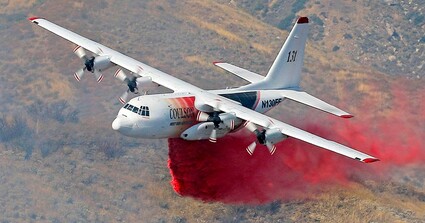Firefighting from 10,000 feet
Last updated 6/28/2022 at Noon
Wildland firefighting is dangerous and dirty work, with every imaginable hazard beyond the fire — falling limbs, toppling trees, smoke inhalation, fall, and poisonous snake bites, to name a few. While most firefighting is done on the ground at close range, it’s the support of aircraft that is often the deciding factor of controlling the fire.
Sisters Country residents are no strangers to wildland fires or the sight of aerial tankers and helicopters dropping retardant or water on the flames. It can be a comforting sign when air support arrives to lend a hand.
Fortunately, the support comes from nearby Redmond Air Center, requiring less than a 10-minute flight time. Established in 1964, the Center is often assumed to function only as a tanker base. The Air Tanker Base is one of five components of the Center. “Support is what we do,” said Maurice Evans, Air Center Manager for the U.S. Forest Service, under whose auspices the Center runs.
Evans has been in the firefighting business since 1992 — 30 years. At this time of the year he has responsibility for 200-plus personnel, currently dispersed all over the country.
“Keeping track of everybody and knowing they are safe” is how he describes the most challenging part of his job.
“It’s all about getting them home safely, making sure their training paid off and their commitment to look after each other.”
Hotshots. His team provides support to local, state, and federal agencies as they battle wildfire. Redmond is home to the Redmond Hotshot crew, some of the earliest ground responders to fire, especially those ignited by lightning. They are one of four developmental crews nationwide.
The Redmond Smokejumpers are part of the storied band of firefighters who parachute into hard-to-reach areas to gain leverage over fire otherwise inaccessible by vehicle support. Redmond is one of nine smokejumper bases in the country, with a fulltime crew of 50. The specially designed planes that ferry them are called Sherpas, an apt description.
Fire Cache. It’s difficult to imagine all the gear needed to fight fire, the hundreds of saws, miles of hose, thousands of helmets, and protective clothing. Redmond Fire Cache, one of 15 in the country, is a Type 1 depot that delivers equipment to the fire lines.
Training. Then there’s the Interagency Training Center that teaches wildland firefighting tactics to more than a thousand firefighters each year from across the spectrum. There are 38 to 42 courses taught. Students reside on the “campus” during their qualification training. The goal is for standardized techniques, so that a firefighter on a Colorado fire today and an Oregon fire next week is on the exact same page and an instant benefit to the crew, all of whom could be total strangers to one another.
Aerial support. The tanker base is the most visible part of the Air Center with their fleet of planes — some as large as the biggest airliners — that drop an average of 1 million gallons of retardant each summer. The bright red chemical is made of water, fertilizer, salt, clay, and a coloring agent so it can be easily seen by ground crews.
Often a spotter plane will lead the giant tankers, ejecting a small smoke signal enabling the tanker to drop its load with more precision and efficacy. Retardant will not be used if a ground-based resource officer determines the potential for detrimental environmental impact.
Some of the planes can carry 3,000 gallons, land for refueling, and get back in the air in 12 minutes. The Nugget caught up with Evans as he and his staff are nervously awaiting the peak of the fire season.
In answer to our question of the most rewarding part of his job, Evans said: “Relationships and developing young men and women into leadership positions.” He expressed immense gratitude for the support the Air Center gets from the communities and agencies they serve.
Dispatch. Redmond Air Center is also home to Central Oregon Interagency Dispatch Center to make sure the right equipment and crews are assigned to a fire. Serving the Oregon Department of Forestry, Bureau of Land Management and the Forest Service, the dispatchers are crucial in getting ahead offire or keeping one from exploding. It is not uncommon for them to be co-ordinating the movements and positioning of 1,000 governmental personnel and as many as 500 contractor employees.

BILL BARTLETT
Maurice Evans, Air Center manager for the U.S. Forest Service, operating out of Redmond.
There are never enough hands to fight all the fires that in some cases can burn for months and consume hundreds of thousands of acres. The Redmond dispatchers are part of the National Interagency Fire Center based in Boise, where firefighting efforts from every state are coordinated. It’s a delicate balancing act often requiring gut-wrenching decisions about where to deploy.
Firefighting is physically demanding. While everybody from hotshots to smoke jumpers get regular physical training, it is the science of wildfire fighting that is even more important. Climatology is critical to thejob, being able to forecast winds, heat, and moisture. Weather can be a firefighter’s best friend or worst enemy.
Web and Joyce Cosby, who live near Squaw Creek Canyon Estates, have seen their share of tankers fly over their property in recent years.
“It’s always a good feeling,” Web said.
“It’s very reassuring,” Joyce added.
Both are grateful for Sisters’ proximity to the Redmond Air Center.


















Reader Comments(0)